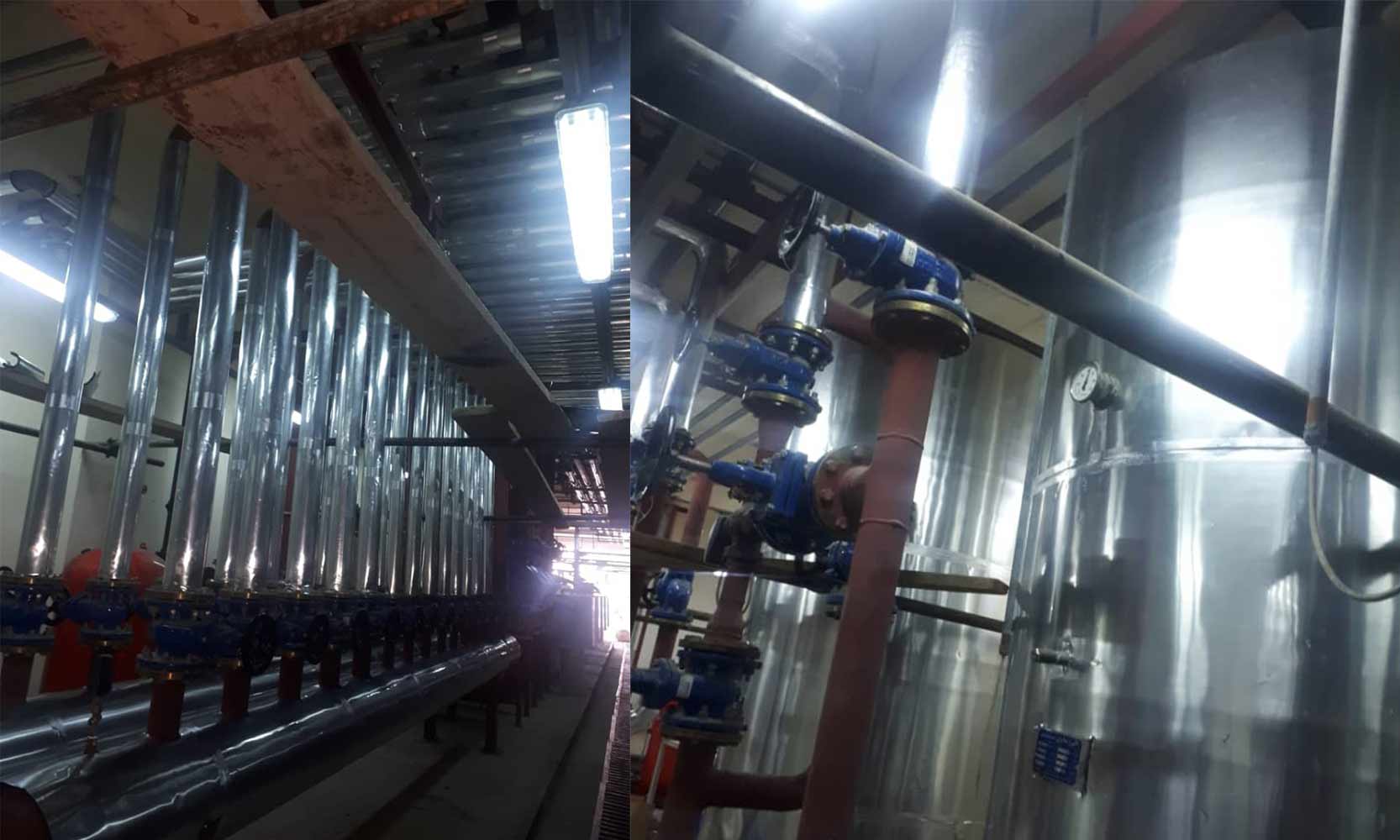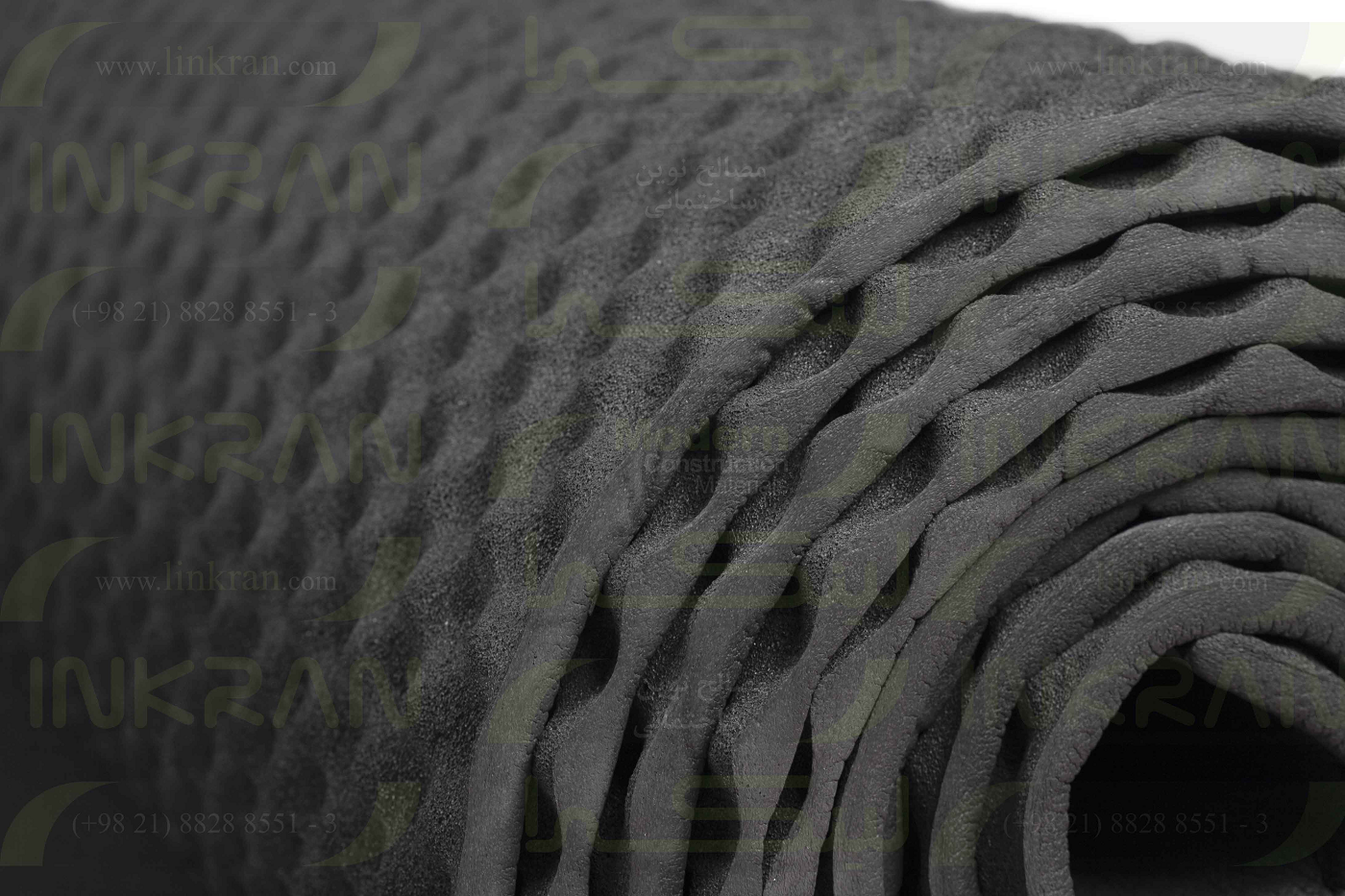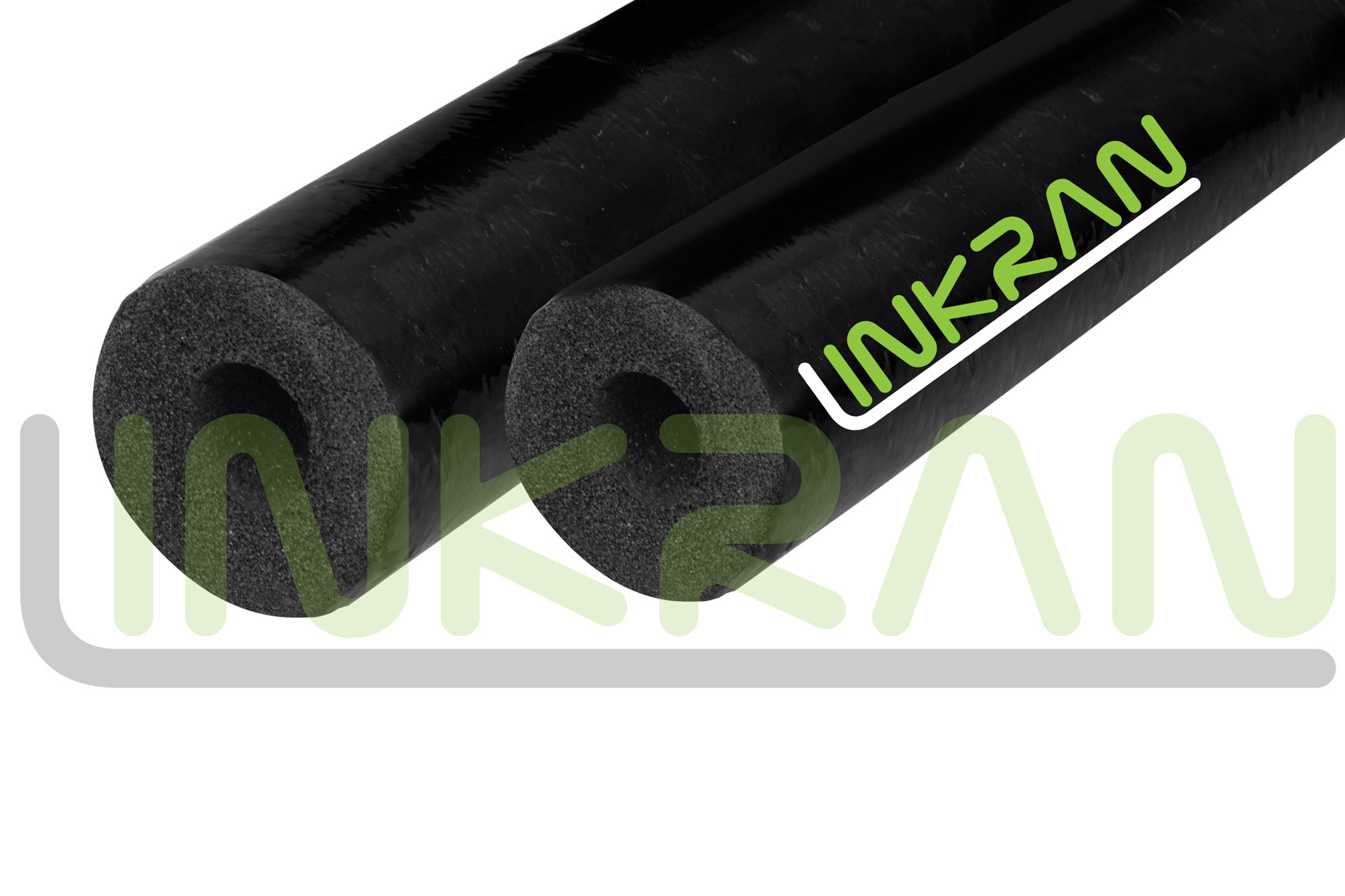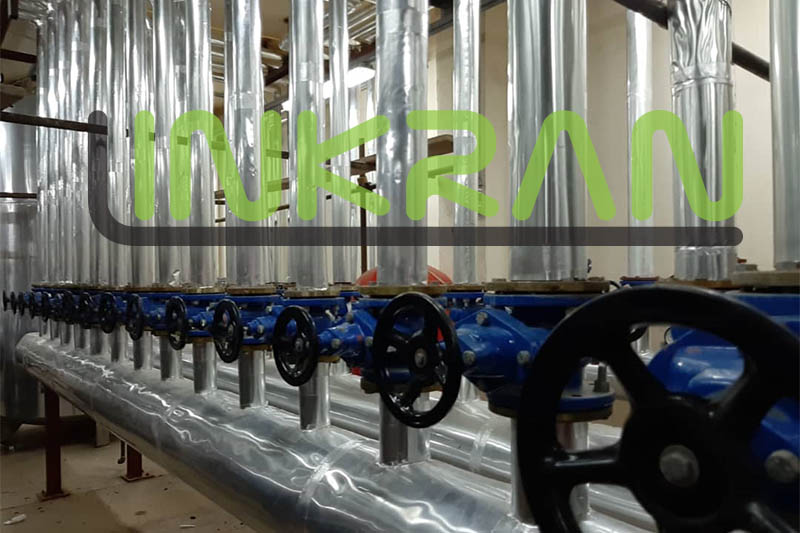Elastomeric Insulation
Elastomeric Insulation is a type of thermal and sound insulation with a closed-cell structure and is highly flexible. The major characteristics of LINKRAN elastomeric insulation are 100% of pipe corrosion prevention, energy loss prevention and condensation prevention
Moments with the largest Elastomeric Insulation Production line
Characteristics of thermal elastomeric insulation
The most important and obvious characteristics of insulators are their thermal properties and especially their thermal resistance. The insulations with higher R factor are better ones. In addition, there are other characteristics that make the use of an insulator desirable. The most important factors are the stability, density, price and effects of insulation on human’s health and environment, as well as the amount of toxic substances emitted in different situations, as well as in the case of fire. The thermal, mechanical and chemical characteristics of insulators are other factors that have a significant impact on the desirability of insulation. Elastomeric insulation is one of the most important inventions in the construction industry that combines all health factors and quality standards
Definition of insulation and its types
Insulation is generally refers to materials that control the flow of energy or some materials in a section and prevent or minimize their penetration into the desired sections. Since the main purpose of insulating is to reduce heat transfer, so insulations must have the desired characteristics in reducing the rate of heat transfer through conduction, convection and radiation. In terms of use, insulations are divided into five categories: thermal insulation, moisture insulation, electrical insulation, fireproof insulation and sound insulation. In the terms of the construction thermal load, the most considered type is thermal insulation. LINKRAN elastomeric insulation is produced for thermal and acoustic thermal insulation

Types of elastomeric insulation and insulating methods
Thermal insulation of buildings which is done to reduce energy loss is classified into three methods
- Internal thermal Insulation:
In this method, insulating is performed by adding a layer of moisture insulation on the outside of the work
- External Thermal Insulation:
In this method, insulating is performed by adding a layer of thermal insulation on the outer side
- Applying materials with low thermal conductivity during the construction. This method is not widely used due to the high cost of production and sometimes due to lack of sufficient access to suitable materials

How to divide the different types of thermal insulation
There are different classifications of insulations, each with a specific basis. These divisions are based on the shape and molecular structure, the origin, the material, the installation method, and so on. Here we refer to the classification of different types of thermal insulation including elastomeric insulation (elastomeric thermal insulation) based on their origin.
Mineral fiber insulation
The three most common types of mineral fibers are:
Glass wool is made of glass. It is one of the most common and oldest insulation available in the market.
Rock wool is made of Basalt which is a type of igneous rock.
Slag wool made of blast furnaces slag.
Natural insulations
Cellulose: Cellulose insulation is made of paper products, especially recycled newspapers. This insulation is often available in bulk. Cellulose has a good capacity to be blown into the pores of the walls, especially the gable roof.
Linen insulation
These insulations are made of recycled materials and are made of linen and other natural fibers. Using this insulation is not very common.
Elastomeric insulation
Thermal insulation material is cellular plastic on the basis of expanded vinyl chloride polymers. The cellular structure consists of closed cells. The high moisture resistance is one of the outstanding features of the Elastomeric insulation. Consequently, the vesicular structure of elastomeric insulation has millions of tiny walls that prevent liquid migration. This feature not only minimizes moisture-related hazards such as mold, but also ensures long-term and stable temperature performance.
Elastomeric insulation has a high resistance to steam penetration and is a very suitable and dense choice on facilities. After calculating the thickness of the required elastomeric insulation to prevent energy loss, you can use a special type of elastomeric insulation
Elastomeric insulation information
Elastomeric foam insulation was developed in the 1950s. The introduction of this and other polymer-based materials marked an important industry transition from the use of natural materials, such as cork, to the use of synthetic materials and chemicals. The popularity of elastomeric insulation grew quickly, primarily because it eliminated the need for any type of vapor barrier to prevent the transference of moisture. As availability of the insulation in various forms (including sheets, rolls, and tubes) increased, so did its popularity as an insulator, especially in refrigeration piping and ductwork applications. It was a user-friendly alternative to other materials because it could be bonded reliably to a variety of surfaces, it was easy to install, and its performance could not be compromised by tears or puncture

Demand for elastomeric foam has increased sharply over the last 2 decades due to heightened awareness of indoor air quality (IAQ). Since elastomeric foam does not contain formaldehyde or fibers, and has very low volatile organic compounds (VOCs), it has found wide acceptance among IAQ advocates. Because of its non-particulating, smooth surface and moisture resistance, elastomeric foam does not support the growth of mold—arguably one of the most devastating IAQ problems that facilities face.
Closed-cell structure elastomeric insulation has had a successful experience as thermal insulation in the mechanical installation industry. Because elastomeric insulation has many advantages over glass wool insulation, it is now widely used in the mechanical installation industry. It is interesting to note that elastomeric insulation is one of the requirements for construction installation in the west and all around the world
:Standards
ASTM C534 Grade I – ASTM C534 Grade II – ASTM C534 Grade III
Elastomeric insulations are closed-cells flexible cellular materials and are based on Polyvinyl Chloride (PVC), Nitrile Butadiene Rubber [1] (NBR) or Ethylene Propylene Dien Monomer Rubber (2) (EPDM)
NBR rubber also known as Buna-N and Perbunan, is a synthetic rubber composed of Acrylonitrile Polymer (ACN) and Butadiene. Their brands name are: Nipol, Krynac and Europrit
EPDM rubber is a synthetic and elastomeric rubber and has a wide range of applications. EPDM rubber usually provides excellent thermal resistance. Closed-cell insulation materials have excellent resistance against the water vapor penetration. So that after installation, no steam or water barrier is needed. The high resistance to vapor, along with the High rubber radiation property, allows the flexible closed cell materials with a relatively small thickness prevent surface contamination. As a result, such materials are widely used in cooling, plumbing and ventilation systems. Of course, such materials can also be used in hot water and heating lines
Although Elastomeric insulations are more expensive than rock wool or fiberglass, are highly cost-effective and have a very high stability due to no need for double coverage (Jacketing) for low temperature applications. The fastest way to insulate pre-fabricated plumbing systems is to use elastomeric insulation. These type of insulations have a very low heat transfer coefficient and are flexible and are very suitable for small work spaces
Sazeh Paidar Elahie Group is the largest and the most reliable company that supply modern materials of construction industry by trusting in God and the Iranian youth’s effort; with exclusive representation of Armasel and Vanflex brands, is the pioneer supplier of elastomeric insulation in the country. Sazeh Paidar Elahie Group collaborated with Fan Top Company, has succeed to produce LINKRAN elastomeric insulation, which equals to foreign competitors in terms of quality, except that it is offered at a much more affordable price for dear consumers
Advantages of Elastomeric insulation
- LINKRAN's elastomeric insulation is resistant to steam and moisture penetration, no need for additional barriers
- A closed-cell structure that causes heat transfer coefficient (K-VALUE) at using time, as well as very low water absorption and high resistance to moisture
- In a non-polar structure with a Polymer-saturated plane of elastomeric insulation, the result is resistance to ultraviolet radiation (UV, atmospheric conditions and lack of moisture absorption
- Fixed and low heat transfer coefficient 0.034 w / mk at zero degrees Celsius
- The thermal range of elastomeric insulation at temperatures between -200 and +125 degrees Celsius
- Flexibility of elastomeric insulation and easy installation with clean and tidy appearance
- LINKRAN elastomeric insulation does not require metal coatings in the open spaces
- Do not cause corrosion under the insulation in the pipe, duct and tanks
- Nonflammable, Fire- resistant and Self-extinguishing
- Resistant to chemicals, acids and alkaline substances
- The best alternatives for rock wool, glass wool, polyurethane, polyethylene
- Easy installation and suitable for small working spaces
- Resistance of Elastomeric insulation against pollution, dust, moisture and water vapor and therefore resistant to biological pollution.High stability
- Elastomeric insulation resistance against ozone and ultraviolet
- Elastomeric insulation resistance against corrosion
- Facile to install with self-clamp. Proper for environments with small work space
- Fibreless and no dust production
- Flexible
- Non-toxic
- Variety of external jacketing and covering are available for these insulations (however, jacketing is not required in many applications)
- High adhesiveness and colorable
- Resistant to pressure and stroke
Disadvantages of elastomeric insulation
- Higher price comparing with rock wool and glass wool
- Elastomeric closed-cell insulation materials are one of the thermosets, which means that they gradually break down and decompose in the prolonged exposure of the high temperature. If the temperature rises, the elastomeric materials gradually lose their elasticity. And without any significant dimensional changes, they become fragile (and may break due to stroke). If the temperature drops again and is within the allowable range, elastomeric materials regain their elasticity and become flexible again
- Usually, the sound transmission coefficient of flexible materials is higher than rock wool and glass wool (as they are not sound insulation), because their density and rigidity are higher than mineral wool and glass wool
Why we have to use NBR insulations?
Energy consumption optimization by using new materials is one of the most common topics in today's world. The main energy consumption is the energy required for heating, cooling in residential, commercial and industrial buildings, and one of the best ways to prevent the heating and cooling energy loss is to use insulation
Thermal elastomeric insulation is made of Nitrile Butadiene Rubber foam (NBR). These insulations are used in refrigeration systems, HVACs, installations, constructions, insulating roofs of sheds, solar energy devices, canals, shipbuilding, oil, gas and petrochemical industries. The temperature range of these insulations is from -200 to +150 degrees Celsius and they are elastomeric sound insulators in thicknesses above 20 mm db32
:The most important features of elastomeric sound insulation are as follows
- Temperature transfer coefficient at zero temperature: 0.036 W / (m.k)
- Water vapor diffusion resistance: 10,000 <µ
- Complete closed-cell structure: over 95%
- High resistance to chemicals
- Oil and grease resistance
- Inflammable
- Prevent corrosion
- Ecofriendly
- High flexibility
- Easy and quick installation
- The highest rate of energy loss prevention
- Prevention of energy dissipation
- High longevity
- Resistant to temperatures between -200 to +105 degrees Celsius
- High flexibility and no need of prefabricated parts
- Free of any dust and fibers, halogen, CFC and HCFC
- High resistant to fire, oil, grease, fungus and chemicals
- It can be provided in form of prefabricated tubular and rolled insulation, with various sizes, thicknesses and different aluminum, polymer and colorable coverings.

Application
Therefore, according to what has been said, elastomeric insulation is the best alternative instead of rock wool, glass wool, polyurethane, polyethylene insulations. Elastomeric insulation is widely used in cooling, plumbing and HVACs systems. Of course, such materials can also be used in hot water pipes and heating lines.
A) Tubular insulation for hot water pipeline system
Elastomeric tubular insulation is very effective in reducing heat loss in internal and external hot water pipeline system. This type of LINKRAN elastomeric insulation is the best insulation for exterior lines for the solar heating system due to its unique resistance to UV and ozone and weather conditions.
LINKRAN elastomeric insulation does not contain any asbestos, particles or dust. Therefore, it is safe to install in places where hygiene is very important. This is one of the thousands of reasons why this product has been widely considered and chosen as an alternative to fiber insulation materials for hot water pipeline systems in hotels, hospitals, residential and industrial buildings.
This type of insulation is an ideal insulation substance for hot water pipeline systems because:
- High temperature range up to about 125 degrees Celsius
- High resistance to ozone, UV, bad weather conditions
- Low and invariable thermal conductivity
- Very low water absorption and high resistance to moisture
- Flexibility, easy to install and no need for covering or protection even for external usage.
B) Elastomeric insulation for air duct systems
The elastomeric insulation is used as an ideal insulation for air duct systems due to absence of fiber and dust. Considering the potential dangers to human health due to release of fibrous materials in the air vents, this insulation has been widely considered compared to fibrous insulating materials.
Elastomeric insulation is applicable without any skin allergies. These insulations also have the best resistance to moisture, fungal growth and vermin and rodents throng. Also, the dense surface of this insulation eliminates the need for a layer as a barrier or any covering to steam.
The physical resistance of elastomeric materials ensures a long service life and a constant and low heat transfer coefficient. LINKRAN elastomeric insulation can also be used for internal and external insulation of all air duct systems.
C) Elastomeric insulation cooling systems and cold water pipelines
Elastomeric insulation cooling systems and cold water pipelines is not only used to control condensate problems but also to reduce energy loss.
Elastomeric insulation is widely used in the central cooling system for the following reasons:
- Constant and low heat transfer coefficient
- Very low water absorption
- Compliance with most ignition standards (Non-flammable and fire resistant)
- Closed-cell structure, high resistance to water and moisture
- Flexibility and easy installation with well-ordered appearance
- The external use of elastomeric insulations does not require covering
LINKRAN elastomeric insulation in various laboratories inside and outside the country received the approval of Iranian and foreign engineers. The report of these experiments is available and can be provided to all dear visitors

Effects of operating temperature on elastomeric insulation products
NBR-based elastomeric closed cell foam insulation products include a polymer mixture of nitrile butadiene rubber (NBR) and polyvinyl chloride (PVC) rubber. Elastomeric insulation is a polymeric mesh material (with latitudinal connections). The recommended operating temperature range is between -290°F up to +220°F. These products are apt to physical changes (especially in continuous applications) when exposed to very high temperatures, but these changes do not affect the thermal performance of the product
When the products are exposed to low temperatures, they become stiff immediately and harden suddenly when the temperature reaches -40° F. This change in mode does not affect the thermal performance of the product. These changes in physical properties are reversed when the ambient temperature rises (they are reversible)
When elastomeric insulation is exposed to higher temperatures, it gradually becomes stiffen (depending on the time of exposure and temperature). Changes in physical properties do not affect the thermal performance of the product. Changes are limited to the inner core of the insulating material when the product creates a temperature gradient in the wall thickness. Therefore, the outer part is protected from exposure to high temperatures and its effects. Changes in physical properties are reversible
What is the effect of hardening of elastomeric insulation, when it is exposed to high temperatures? During the outwearing process, the oxidation creates free radicals, attacking to the double transplantation and part of the acrylic nitrile polymer mixture which causes more latitudinal connections and makes it harder or more fragile. This process is a reaction related to temperature and time. At relatively low temperatures (F180) over a long period of time, the product will show signs of hardening. At higher temperatures, the process accelerates. At high temperatures, the F250 has a double acceleration process and causes the product to harden quickly in a relatively short time
Applying the panel elastomeric insulation in direct contact with a hot surface, such as tanks and ducts, have a greater potential for temperature effects than for a pipe that has a greater air gap between the insulation and the pipe. Experiments have shown that this hardening process does not affect the thermal performance of the product
Since most thermal applications are static applications, hardening does not affect the performance of the product during operation. However, the effects of continuing high temperatures on elastomeric insulation should be used when determining the product, especially if the insulation is to be applied to a tank, container, or clean room. Be considered

Chemical resistance of elastomeric insulation
Elastomeric insulation is an ideal choice for use in installation piping systems containing cold fluid and wherever there is a possibility of moisture and water due to bad climate conditions or condensation.
Elastomeric insulation products have excellent chemical resistance over a wide range of chemicals. Elastomeric insulation materials can be based on NBR or EPDM. NBR-based elastomeric products can include additives such as PVC (polyvinyl chloride), ABS (acrylic nitrile butadiene styrene) or other plastic additives. The chemical resistance of the product will be based on the primary polymer on which the product is based.
Chemical resistance depends on several parameters, such as the level of exposure to environmental conditions, the chemical density, and the ambient temperature of the used space. In cases where the base material does not provide sufficient chemical resistance, a jacket can be used as a protector.
Generally, it can be said that the level of exposure to environmental conditions, chemical density and temperature play a key role in determining whether insulation can be used in the intended application or not

Write a Comment